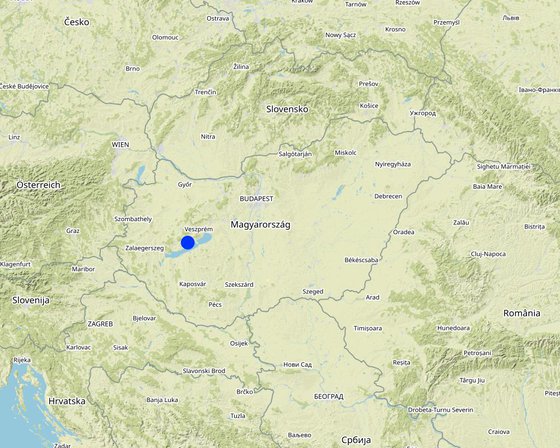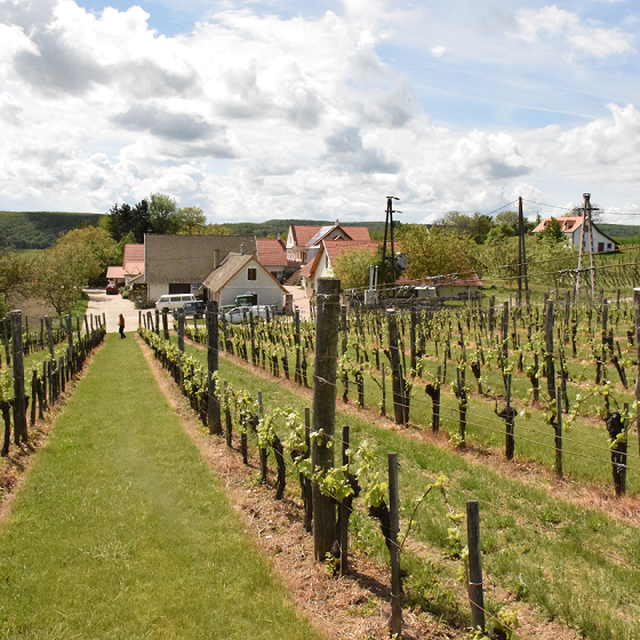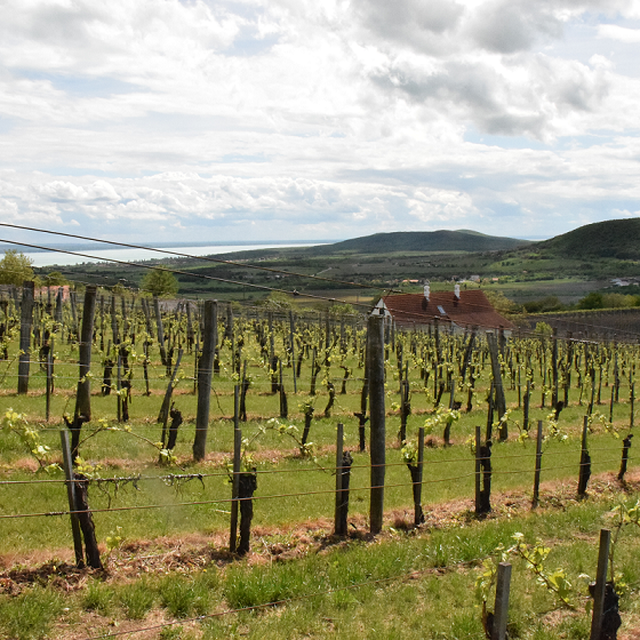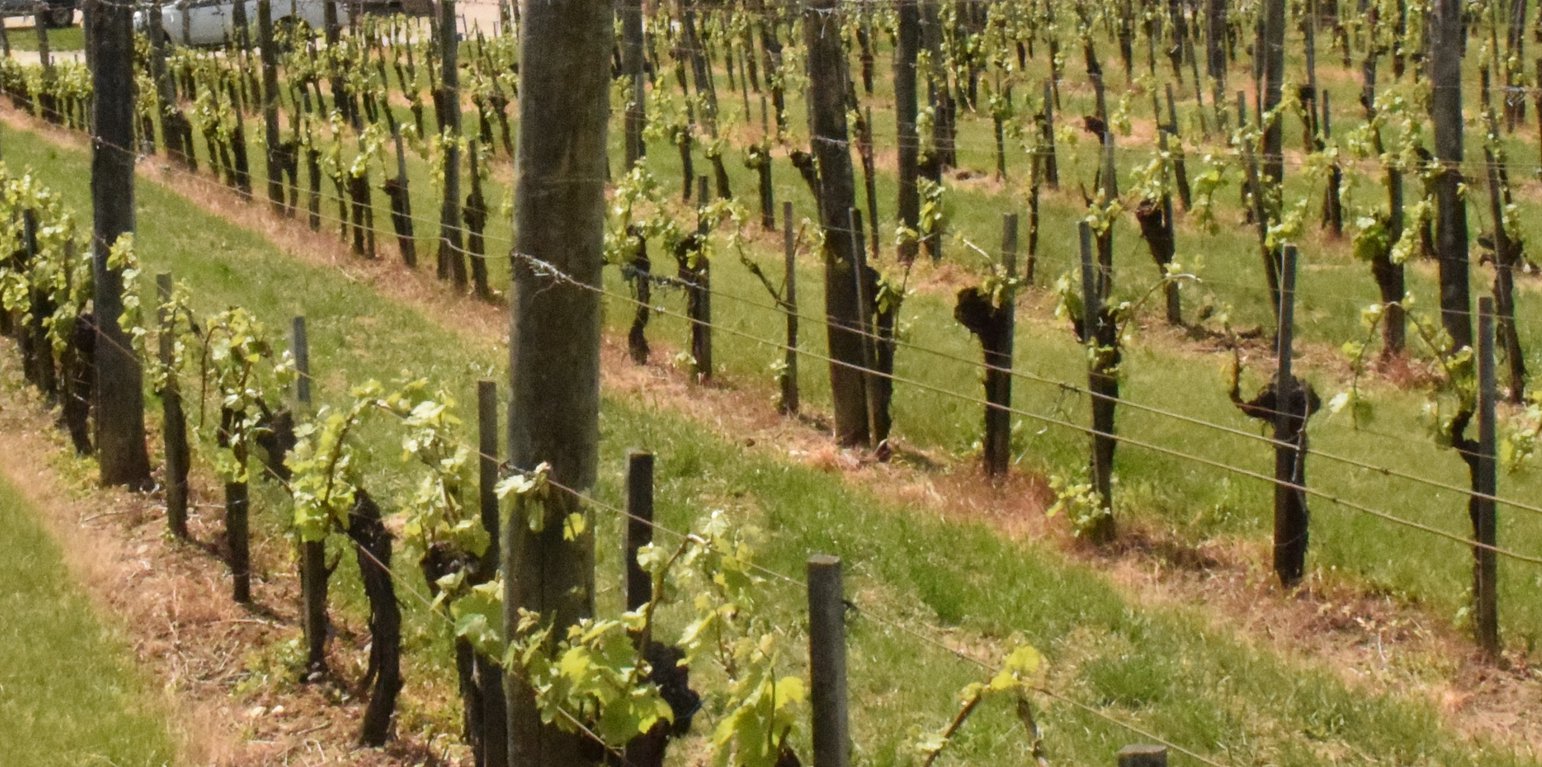Permanent grass cover in vineyards
(Hungary)
Sorközök füvesítése szőlőben
Description
Permanent grass cover under grape vines protects the soil surface against erosion and compaction - and provides better conditions for traffic within the rows during mechanised field operations
Permanent grass cover under grape vines protects the soil surface against erosion and compaction - and provides better conditions for traffic within the rows during mechanised field operations. Grass can be sown using a mixture of grass and legume species - white clover, red clover, tall fescue are the most widely used - or it can be allowed to germinate naturally after stopping regular tillage applications. For the maintenance of grass cover and to avoid the disadvantages of tall grass it must be regularly cut. The height of the grass is most important directly below the grape rows. Grass clippings are a great source of nitrogen and break down quickly, so it can be used as mulch. But winegrowers/farmers who deal with animal husbandry too, prefer to use grass clippings as fodder. Herbicides are often used to control the grass in narrow strips underneath the grape rows.
One benefit of the grass cover is the good soil protection on slopes - where vineyards are often established due to better exposure to the sun. In addition, it gives better traction for machines, especially on steep gradients: this is appreciated by land users. Permanent grass cover makes for a cooler and more humid microclimate in the vineyard, but this means a greater risk of fungal diseases and loss of moisture due to the transpiration demand of the grass.
Location

Location: Szentantalfa, Veszprém County, Hungary
No. of Technology sites analysed: 10-100 sites
Geo-reference of selected sites
Spread of the Technology: applied at specific points/ concentrated on a small area
In a permanently protected area?: No
Date of implementation: 10-50 years ago
Type of introduction
-
through land users' innovation
-
as part of a traditional system (> 50 years)
-
during experiments/ research
-
through projects/ external interventions

Green cover of grass in vineyard (Levente Czelnai)

Green cover (grass) in vineyard (Levente Czelnai)
Classification of the Technology
Main purpose
-
improve production
-
reduce, prevent, restore land degradation
-
conserve ecosystem
-
protect a watershed/ downstream areas – in combination with other Technologies
-
preserve/ improve biodiversity
-
reduce risk of disasters
-
adapt to climate change/ extremes and its impacts
-
mitigate climate change and its impacts
-
create beneficial economic impact
-
create beneficial social impact
Land use
Land use mixed within the same land unit: No
-
Cropland
- Tree and shrub cropping: grapes
Water supply
-
rainfed
-
mixed rainfed-irrigated
-
full irrigation
Purpose related to land degradation
-
prevent land degradation
-
reduce land degradation
-
restore/ rehabilitate severely degraded land
-
adapt to land degradation
-
not applicable
Degradation addressed
-
soil erosion by water - Wt: loss of topsoil/ surface erosion, Wg: gully erosion/ gullying
SLM group
-
improved ground/ vegetation cover
SLM measures
-
vegetative measures - V2: Grasses and perennial herbaceous plants
Technical drawing
Technical specifications
The interrow space between grape lines are covered by permanent grass. Interrow space is 2-3 m.

Author: Piroska Kassai
Establishment and maintenance: activities, inputs and costs
Calculation of inputs and costs
- Costs are calculated: per Technology area (size and area unit: ha)
- Currency used for cost calculation: USD
- Exchange rate (to USD): 1 USD = n.a
- Average wage cost of hired labour per day: 50
Most important factors affecting the costs
fuel prices
Establishment activities
n.a.
Maintenance activities
-
cutting grass (Timing/ frequency: 4-5 times a year)
Maintenance inputs and costs (per ha)
| Specify input |
Unit |
Quantity |
Costs per Unit (USD) |
Total costs per input (USD) |
% of costs borne by land users |
|
Other
|
| 1st cutting grass is carried out by a contractor |
ha |
1.0 |
35.0 |
35.0 |
100.0 |
| 2nd cutting grass is carried out by a contractor |
ha |
1.0 |
35.0 |
35.0 |
100.0 |
| 3rd cutting grass is carried out by a contractor |
ha |
1.0 |
35.0 |
35.0 |
100.0 |
| 4th cutting grass is carried out by a contractor |
ha |
1.0 |
35.0 |
35.0 |
100.0 |
| 5th cutting grass is carried out by a contractor |
ha |
1.0 |
35.0 |
35.0 |
100.0 |
| Total costs for maintenance of the Technology |
175.0 |
|
| Total costs for maintenance of the Technology in USD |
175.0 |
|
Natural environment
Average annual rainfall
-
< 250 mm
-
251-500 mm
-
501-750 mm
-
751-1,000 mm
-
1,001-1,500 mm
-
1,501-2,000 mm
-
2,001-3,000 mm
-
3,001-4,000 mm
-
> 4,000 mm
Agro-climatic zone
-
humid
-
sub-humid
-
semi-arid
-
arid
Specifications on climate
Average annual rainfall in mm: 600.0
Slope
-
flat (0-2%)
-
gentle (3-5%)
-
moderate (6-10%)
-
rolling (11-15%)
-
hilly (16-30%)
-
steep (31-60%)
-
very steep (>60%)
Landforms
-
plateau/plains
-
ridges
-
mountain slopes
-
hill slopes
-
footslopes
-
valley floors
Altitude
-
0-100 m a.s.l.
-
101-500 m a.s.l.
-
501-1,000 m a.s.l.
-
1,001-1,500 m a.s.l.
-
1,501-2,000 m a.s.l.
-
2,001-2,500 m a.s.l.
-
2,501-3,000 m a.s.l.
-
3,001-4,000 m a.s.l.
-
> 4,000 m a.s.l.
Technology is applied in
-
convex situations
-
concave situations
-
not relevant
Soil depth
-
very shallow (0-20 cm)
-
shallow (21-50 cm)
-
moderately deep (51-80 cm)
-
deep (81-120 cm)
-
very deep (> 120 cm)
Soil texture (topsoil)
-
coarse/ light (sandy)
-
medium (loamy, silty)
-
fine/ heavy (clay)
Soil texture (> 20 cm below surface)
-
coarse/ light (sandy)
-
medium (loamy, silty)
-
fine/ heavy (clay)
Topsoil organic matter content
-
high (>3%)
-
medium (1-3%)
-
low (<1%)
Groundwater table
-
on surface
-
< 5 m
-
5-50 m
-
> 50 m
Availability of surface water
-
excess
-
good
-
medium
-
poor/ none
Water quality (untreated)
-
good drinking water
-
poor drinking water (treatment required)
-
for agricultural use only (irrigation)
-
unusable
Water quality refers to: surface water
Is salinity a problem?
Occurrence of flooding
Characteristics of land users applying the Technology
Market orientation
-
subsistence (self-supply)
-
mixed (subsistence/ commercial)
-
commercial/ market
Off-farm income
-
less than 10% of all income
-
10-50% of all income
-
> 50% of all income
Relative level of wealth
-
very poor
-
poor
-
average
-
rich
-
very rich
Level of mechanization
-
manual work
-
animal traction
-
mechanized/ motorized
Sedentary or nomadic
-
Sedentary
-
Semi-nomadic
-
Nomadic
Individuals or groups
-
individual/ household
-
groups/ community
-
cooperative
-
employee (company, government)
Age
-
children
-
youth
-
middle-aged
-
elderly
Area used per household
-
< 0.5 ha
-
0.5-1 ha
-
1-2 ha
-
2-5 ha
-
5-15 ha
-
15-50 ha
-
50-100 ha
-
100-500 ha
-
500-1,000 ha
-
1,000-10,000 ha
-
> 10,000 ha
Scale
-
small-scale
-
medium-scale
-
large-scale
Land ownership
-
state
-
company
-
communal/ village
-
group
-
individual, not titled
-
individual, titled
Land use rights
-
open access (unorganized)
-
communal (organized)
-
leased
-
individual
Water use rights
-
open access (unorganized)
-
communal (organized)
-
leased
-
individual
Access to services and infrastructure
employment (e.g. off-farm)
drinking water and sanitation
Impacts
Ecological impacts
surface runoff
Surface runoff decreases because infiltration improves significantly in vineyards with grass cover crops
soil loss
Grass cover crops in vineyards can reduce soil erosion rates by four- to six-times compared to tillage.
micro-climate
Humidity of microclimate is increased, resulting in higher risk of diseases
Off-site impacts
downstream flooding (undesired)
damage on public/ private infrastructure
Cost-benefit analysis
Benefits compared with establishment costs
Short-term returns
very negative
very positive
Long-term returns
very negative
very positive
Benefits compared with maintenance costs
Short-term returns
very negative
very positive
Long-term returns
very negative
very positive
Climate change
Gradual climate change
annual temperature increase
not well at all
very well
seasonal rainfall decrease
not well at all
very well
Climate-related extremes (disasters)
not well at all
very well
not well at all
very well
not well at all
very well
Adoption and adaptation
Percentage of land users in the area who have adopted the Technology
-
single cases/ experimental
-
1-10%
-
11-50%
-
> 50%
Of all those who have adopted the Technology, how many have done so without receiving material incentives?
-
0-10%
-
11-50%
-
51-90%
-
91-100%
Has the Technology been modified recently to adapt to changing conditions?
To which changing conditions?
-
climatic change/ extremes
-
changing markets
-
labour availability (e.g. due to migration)
Using drought-tolerant grass species
Conclusions and lessons learnt
Strengths: land user's view
-
good soil conservation - increases soil organic carbon and improves aggregate stability
-
reduces soil loss
Strengths: compiler’s or other key resource person’s view
-
Less nutrient load through erosion (off-site effect)
Weaknesses/ disadvantages/ risks: land user's viewhow to overcome
-
cutting grass is regulary needed
Weaknesses/ disadvantages/ risks: compiler’s or other key resource person’s viewhow to overcome
-
vineyard microclimate is more humid, resulting in higher risk of diseases
References
Editors
-
Piroska Kassai
-
Zoltan Toth
Reviewer
-
William Critchley
-
Rima Mekdaschi Studer
Date of documentation: March 29, 2022
Last update: April 21, 2023
Full description in the WOCAT database
Documentation was faciliated by
Institution
- Institute for Soil Sciences, Centre for Agricultural Research (ATK TAKI) - Hungary
Project
- OPtimal strategies to retAIN and re-use water and nutrients in small agricultural catchments across different soil-climatic regions in Europe (OPTAIN)
Key references
-
Cover cropping in vineyards - A grower's handbook, Published by Agriculture & Natural Resources 2002-01-01, 2002, ISBN 10: 187990635X / ISBN 13: 9781879906358: From LowKeyBooks (Sumas, WA, U.S.A.)
Links to relevant information which is available online










